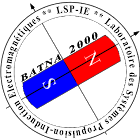, “Adaptive direct power control for double fed induction generator used in wind turbine,” International Journal of Electrical Power & Energy Systems, vol. 114, 2020.Abstract
Équipe 04
, “Modified Robust Model Reference Adaptive System Scheme for a Speed Sensorless Vector Control of Induction Motor,” 19th International Conference on Sciences and Techniques of Automatic Control and Computer Engineering (STA). pp. 473-478, 2019.Abstract
, “Fuzzy –Super twisting control implementation of battery/super capacitor for electric vehicles,” ISA transactions, 2019.Abstract
, “Novel control implementation for electric vehicles based on fuzzy-back stepping approach,” Energy, vol. 178, pp. 644-655, 2019.Abstract
, “Fault-tolerant control of a smart PV-grid hybrid system,” IET Renewable Power Generation, vol. 13 N° 13, pp. 2451-2461, 2019.
, “Implementation of power management based on fuzzy logic for a hybrid PV/Fuel Cell generation system,” International Conference On Emerging and Renewable Energy : Generation and Automation, Sousse-Tunisia. pp. 1-6, 2018.Abstract
, “Direct Power Control of DFIG by Sliding Mode Control and Space Vector Modulation,” 7th International Conference on Systems and Control (ICSC), Valencia, Spain. pp. 462-467, 2018.Abstract
, “An advanced energy management system with an economical optimization for a multi-sources stand-alone Home,” 7th International Conference on Systems and Control (ICSC), Valencia, Spain. pp. 154-159, 2018.Abstract
, “Control and optimal management of a multi-source energy system,” 7th International Conference on Systems and Control (ICSC), Valencia, Spain. pp. 164-168, 2018.Abstract
, “dSPACE Real-Time Implementation Sliding Mode Maximum Power Point Tracker for Photovoltaic system,” 7th International Conference on Systems and Control (ICSC), Valencia, Spain. pp. 137-141, 2018.Abstract
, “The dynamic control and optimal management of the energy in the case of a territory isolated in Batna city,” 7th International Conference on Systems and Control (ICSC), Valencia, Spain. pp. 160-163, 2018.Abstract
, “Experimental control of a Doubly Fed Induction Generator based Wind Energy Conversion System,” 2018 7th International Conference on Systems and Control (ICSC), Valencia, Spain. pp. 142-147, 2018.Abstract
, “Implementation of new adaptive power-split management strategy in a battery-super capacitor electric vehicle,” 2018 International Conference on Electrical Sciences and Technologies in Maghreb (CISTEM) IEEE. pp. 1-6, 2018.Abstract
, “A New Implementation of Maximum Power Point Tracking based on Fuzzy Logic Algorithm for Solar Photovoltaic System,” International Journal of Engineering, Transactions A, vol. 31, no. 4, pp. 184-191, 2018.
